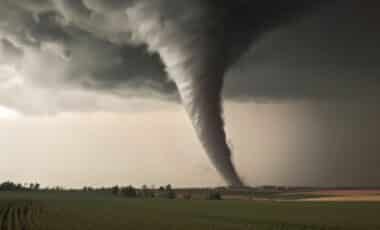Severe weather is on the way, and residents in Texas, Oklahoma, Arkansas, and Louisiana are preparing for extreme conditions this Sunday, June 8. The National Weather Service (NWS) has issued a warning indicating that winds could reach speeds of up to 100 mph in some areas. Along with these dangerous winds, residents could also face hailstones as large as 5 inches in diameter. The combination of high winds, large hail, and the possibility of tornadoes makes this storm a significant threat to both property and personal safety.
Areas Most at Risk
The states of Texas, Oklahoma, Arkansas, and Louisiana are all in the path of this extreme weather event. The Storm Prediction Center forecasts that the worst of the storm will occur during the afternoon and evening hours on Sunday, with conditions gradually improving by nightfall. Some of the cities at the highest risk include Dallas, Fort Worth, and Wichita Falls in Texas. These regions face the greatest threat from high winds and large hail.
In Oklahoma, cities like Oklahoma City, Abilene, and Lubbock are under an “enhanced” risk, meaning the storm could still bring significant damage but not at the same level as Texas. Additionally, Little Rock, Wichita, and Shreveport in Arkansas and Louisiana are under a “slight” risk of severe weather. While these areas will still experience storms, the intensity of the wind and hail is expected to be less extreme.
|3km Bulk Shear + NOAA Radar Comp – OUN/DFW|
— Dale Sams ©️ (@dalesamsWx) June 9, 2025
Complex of storms is ongoing across southern OK/northwest TX. An increase in damaging winds up to 100mph is likely over next few hours. A PDS watch will likely be needed to replace WW397 by top of the hour. @NWSSPC #txwx #SevereWx pic.twitter.com/j02fnFVbY5
The Threat of a Derecho Storm
Meteorologists are concerned that this storm could develop into a derecho, a type of powerful and fast-moving storm that can cause extensive damage. Derechos are known for producing straight-line winds, which can rival the power of tornadoes. These storms are also associated with heavy rainfall and flash flooding, both of which can complicate efforts to manage the storm’s impact.
The risk of tornadoes is another significant factor, as these types of storms often generate rotating columns of air capable of causing widespread destruction. The NWS has emphasized that the storm could lead to power outages, damaged homes, and downed trees. As such, residents are advised to take action quickly and follow official warnings closely.
Preparing for the Worst
With the storm fast approaching, the National Weather Service is urging residents in affected areas to prepare in advance. They suggest securing any outdoor items that could be picked up by the high winds, including objects like trampolines, lawn furniture, and other loose items. These objects, if lifted by the wind, can cause significant damage and pose a danger to both homes and people.
In addition to securing property, residents are urged to stay informed through local weather updates and to be ready to seek shelter immediately if the storm worsens. The NWS recommends that people remain indoors during the storm and avoid unnecessary travel. Those in the high-risk zones should have an emergency kit on hand and know the nearest shelter locations in case the storm escalates quickly.
Timing and Duration of the Storm
The severe weather is expected to develop throughout the afternoon and evening, with conditions likely starting to improve by nightfall. The National Weather Service has emphasized that storms will move rapidly, so people should not wait for the storm to arrive before taking action. The warning encourages everyone in the affected areas to stay alert for official updates and to act swiftly when a warning is issued.
As the storm approaches, it’s critical for residents to remain aware of any changes in the weather. The NWS has stressed that storms can intensify quickly, and those in the storm’s path should be ready to adapt to changing conditions.









